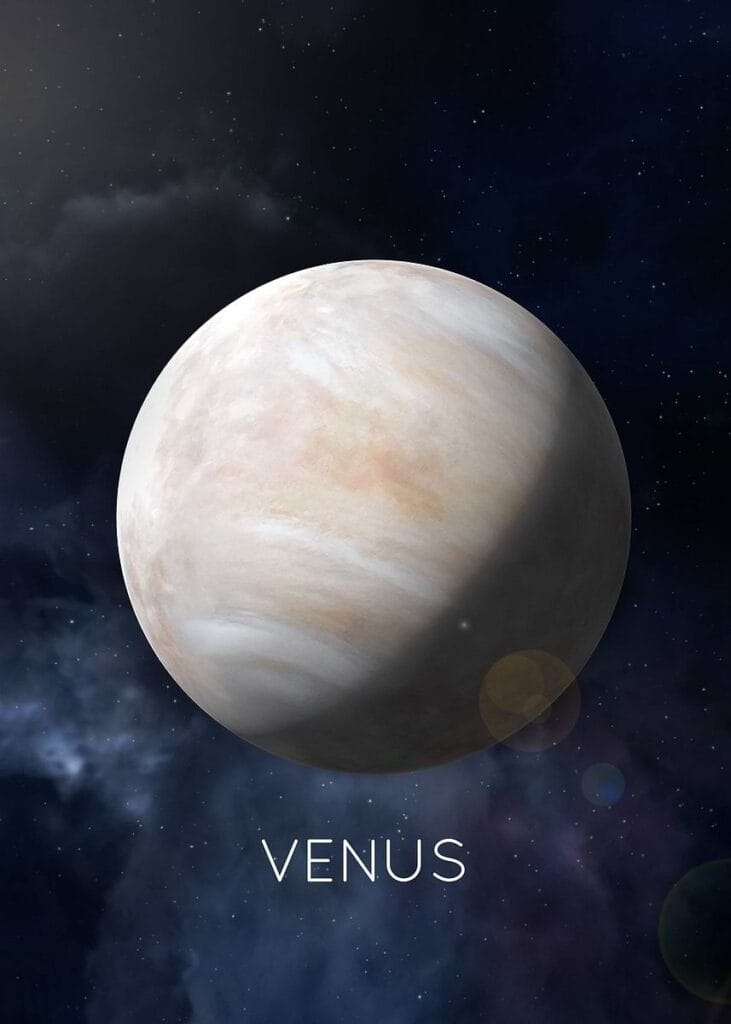Life on Venus may sound like science fiction, but recent discoveries in the planet’s clouds are making scientists rethink what’s possible.
What is the atmosphere of Venus like?
Venus has a thick atmosphere composed mainly of carbon dioxide, with clouds of sulfuric acid that create a dense, toxic environment. This venusian atmosphere traps heat, causing an extreme runaway greenhouse effect that raises surface temperatures to around 900 degrees Fahrenheit.
Understanding the composition of Venus’ atmosphere
The planet Venus’ atmosphere consists mostly of carbon dioxide, with traces of nitrogen and sulfuric acid clouds. These clouds of sulfuric acid contribute to the planet’s harsh atmospheric conditions and limit sunlight penetration.
How does the atmosphere affect the potential for life?
Venus’ thick atmosphere and extreme temperatures make life on Venus’ surface almost impossible. However, scientists speculate that life could exist in the cooler, more temperate layers of Venus’ clouds, where conditions might support microbial life.
Comparing Venus’ atmosphere to that of Earth
Unlike Earth’s breathable atmosphere, Venus’ atmosphere is dense, hot, and corrosive. Earth’s nitrogen-oxygen atmosphere supports life, whereas Venus’ atmosphere contains clouds of sulfuric acid, making it hostile despite both being rocky planets.
Did you know phosphine was detected in Venus’ clouds, a possible biosignature for microbial life?
What are the signs of life in Venus’ clouds?

Scientists study Venus’ clouds for possible signs of life, focusing on the detection of phosphine gas, which on Earth is associated with biological activity. This phosphine signal could suggest microbial life existing in the venusian clouds.
Evidence of microbial life in the clouds of Venus
The presence of phosphine in Venus’ atmosphere is considered evidence of microbial life, as this gas is unlikely produced by known non-biological processes. This discovery supports the idea that venusian life may exist in the planet’s clouds.
What does the presence of phosphine indicate?
Phosphine detected in Venus’ clouds indicates a potential sign of life because this gas is rare in rocky planet atmospheres and often linked to biological processes on Earth. Its presence challenges scientists to rethink venusian life possibilities.
Read about What Is the Speed of Earth?
How do scientists detect signals in its clouds?
Using telescopes and space probes, scientists detect phosphine and other signals in Venus’ clouds by analyzing atmospheric spectra. These detections are crucial for planetary science and astrobiology, focusing on life in Venus’ clouds.
What missions have been sent to study Venus?
Multiple missions, including NASA’s Pioneer Venus and ESA’s Venus Express, have studied Venus’ atmosphere and surface. These missions provide vital data about atmospheric composition, surface temperatures, and planetary neighbors like Venus.
Overview of NASA’s missions to Venus
NASA’s missions to Venus, such as Pioneer Venus and upcoming Venus orbiters, explore the thick atmosphere, clouds of sulfuric acid, and surface conditions, advancing our understanding of the planet’s harsh environment and potential for life.
Key findings from the Pioneer Venus mission
Pioneer Venus revealed critical data about Venus’ dense atmosphere and extreme surface temperatures. This mission helped confirm the runaway greenhouse effect and mapped the planet’s atmospheric layers, including its thick clouds.
Did you know thesurface of Venus reaches 900°F, yet its upper atmosphere might still support life?
Future missions planned for Venus exploration
Future missions planned for Venus aim to study its atmosphere in more detail, focusing on the detection of phosphine and other biosignatures. These missions could revolutionize the search for life on rocky planets within our solar system.
How does the temperature on Venus impact its potential for life?

Venus’ surface temperature, around 900 degrees Fahrenheit, creates conditions too harsh for life as we know it. However, life could exist in the planet’s lower atmosphere, where thermal conditions are less extreme and potentially support microbial life.
Understanding the extreme surface temperatures
The extreme surface temperatures on Venus result from its thick atmosphere and runaway greenhouse effect. These conditions make the venusian surface inhospitable but highlight the importance of studying the cooler layers above the surface.
Could life exist in Venus’ lower atmosphere despite high temperatures?
Despite high surface temperatures, life on Venus could survive in the planet’s lower atmosphere, where conditions are milder. Scientists explore this region as a potential habitat for microbial life, hidden within the clouds of Venus.
Thermal conditions and their implications for Venusian life
Thermal conditions in Venus’ clouds, especially in the lower atmosphere, may support venusian life forms adapted to extreme acidity and heat. These findings influence the planetary science community’s views on life’s existence beyond Earth.
What role does phosphine play in the search for life on Venus?
Phosphine acts as a crucial biosignature in the search for life on Venus. Its detection in Venus’ atmosphere sparks debate about whether phosphine is produced biologically or through unknown chemical processes on this rocky planet.
How is phosphine produced in the atmosphere of Venus?
On Venus, phosphine might be produced by volcanic activity or chemical reactions, but these sources are unlikely to account fully for detected levels. This uncertainty strengthens the argument for phosphine as a possible sign of life.
Did you know some Earth extremophiles survive in acidic clouds, like those on Venus made of sulfuric acid?
Why is phosphine considered a potential sign of life?
Phosphine is considered a potential sign of life because, on Earth, it mainly originates from microbial processes. Detecting phosphine in Venus’ atmosphere raises hopes that similar biological mechanisms might occur in its clouds.
Debate surrounding the detection of phosphine gas
The discovery of phosphine gas in Venus’ atmosphere has sparked a scientific debate. Some scientists question the detection methods and alternative chemical sources, while others see it as a breakthrough in astrobiology and the search for extraterrestrial life.
Can Venus harbor life despite its harsh conditions?
Venus could harbor life, especially in its cloud layers, despite the planet’s harsh surface conditions. Extremophiles on Earth show that life can adapt to extreme environments, supporting the possibility of venusian life in the upper atmosphere.
Exploring the concept of extremophiles on other planets
Extremophiles demonstrate life’s ability to survive harsh conditions, encouraging scientists to explore life on planets like Venus. These hardy organisms provide models for venusian life that could exist in clouds with sulfuric acid.
Read also about Life on Mars
What do scientists believe about life on rocky planets?
Scientists believe life on rocky planets depends on stable atmospheres and moderate temperatures. Venus challenges this idea with its extreme atmosphere, but life in Venus’ clouds keeps the search for extraterrestrial life open.
Is there a possibility for Venusian life forms to adapt?
Venusian life forms could adapt to harsh conditions by evolving resistance to acidity and heat. This adaptability suggests that life may persist in the planet’s clouds, making Venus a prime candidate in planetary science and astrobiology.
Frequently Asked Questions about Life on Venus
Can clouds on Venus support life?
Yes, clouds on Venus, especially in the lower atmosphere, could support microbial life. These venusian clouds contain temperatures and pressures more suitable than the planet’s harsh surface, making life in Venus’ clouds a key focus in astrobiology.
How long would a person live on Venus?
A person could not survive long on Venus due to extreme surface temperatures near 900 degrees Fahrenheit and a thick atmosphere filled with sulfuric acid clouds. Venus’ environment is deadly, so human life would be impossible without advanced protection.
What planet did they find life on?
Currently, scientists have not found confirmed life on any planet besides Earth. However, the detection of phosphine in Venus’ atmosphere suggests potential microbial life in the clouds of Venus, making this rocky planet a prime target for future exploration.
Could Venus, our scorching neighbor, actually harbor life? Keep exploring space with us to find out what’s hiding in the clouds!
Read also about saturn moons